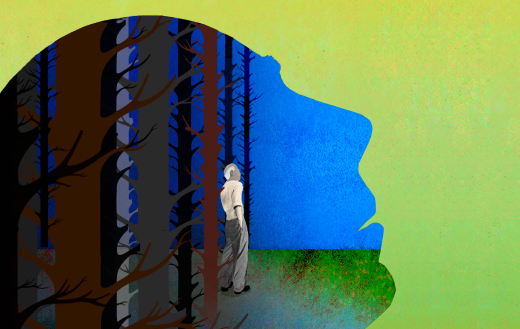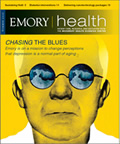Out of the Woods

by William McDonald
Depression in older people is often hidden in a dark thicket of other diseases. But with efforts between neurology and psychiatry at Emory, it is being found—and treated.
Twenty years ago, Emory neurologist Mahlon DeLong began investigating a neuro-surgical procedure, pallidotomy, that dramatically reduced the tremors and rigidity in many patients with Parkinson’s disease. Pallidotomy maps, then destroys, cells in the region of the brain that control involuntary movements. Surprisingly, however, some of the patients with the most dramatic improvement in physical symptoms after pallidotomy did not describe themselves as improved. They did not feel any better. They continued to experience the same dark mood and sense of hopelessness they had before the procedure, a depression that their families and doctors may have assumed would go away when the physical symptoms improved. By contrast, patients with Parkinson’s but no depression (and a few with it) reported much more satisfaction after pallidotomy, even when their results were less impressive.
That says a lot about the complex relationship between neurologic and psychiatric problems and how untreated depression can affect, even counteract, the treatment of other diseases.
When I arrived at Emory in 1993, neurology and psychiatry began working more closely together to understand what was happening with these puzzling patients and how we could improve outcomes. We knew that two of every five patients with Parkinson’s, or 40%, also had depression. We discovered that the level of depression patients suffered before or after pallidotomy was not correlated with the severity of their motor problems. We began to suspect that the depression was not just a reaction to increasing debility or pain but more likely had an organic basis, something to do with which cells in the brain were affected by Parkinson’s.
As a practical matter, we realized we should screen for depression and other psychiatric disorders (now done routinely before transplantation and certain other surgeries) and that we should treat those disorders before pallidotomy.
Today deep brain stimulation (DBS) largely replaces pallidotomy for treating the symptoms of Parkinson’s. It involves surgical implantation of a stimulating electrode. Patients can receive the same benefit as pallidotomy for their motor symptoms while no cells are destroyed. The procedure, therefore, is potentially reversible. Interestingly, when used to treat the tremor of Parkinson’s, DBS may cause psychiatric symptoms, including suicidal thoughts. But when the stimulator is placed in a different part of the brain that controls emotions and not movement, DBS can relieve depression. Currently, Helen Mayberg in our department and Bob Gross in neurosurgery are studying the potential benefits of DBS on treatment-resistant depression.
In collaboration with neurology, we also are studying depression and anxiety in other common neurologic movement disorders such as dystonia. Dystonia causes muscles to contract and spasm involuntarily. A mild form of the disorder is the common “writer’s cramp” whereas more severe forms result in twisting, repetitive movement, and distorted posture. Under the leadership of neurologist H.A. Jinah, I am working with a group of international researchers to investigate the occurrence and significance of psychiatric symptoms in severe forms of dystonia.
The basic interrelationship between depression and other neurologic disorders is also true for conditions that are unrelated to movement, such as the dementias. Treating depression and anxiety in patients with memory and cognition problems—including Alzheimer’s disease—enhances the patient’s quality of life, independence, and the ability to think and communicate. Importantly, we also know that depression in Alzheimer’s may have the most profound effect on the caregiver, who often suffers more than the patient. Much of the clinical work in the Fuqua Center focuses on the caregiver burden, addressing the needs of both the patient and the patient’s family.
Emory’s clinical departments of neurology and psychiatry are teaming up to address the complex overlap between neurologic and psychiatric problems. Together, they are developing a shared clinical program in which all patients with complex neurologic or psychiatric symptoms undergo a two-day neurologic, psychiatric, and neuropsychologic assessment. The health care team then compares notes on each patient’s condition and develops a treatment plan that assures all problems are addressed. This intensive, multidisciplinary approach makes for good clinical care.
Understanding the connections between neurologic and psychiatric symptoms also can teach us about depression in general and specifically about how late-life depression differs from that experienced at earlier stages. Sadness is the predominant sign of depression in younger people, from childhood to middle age, including postpartum depression. Older people, especially those who are experiencing depression for the first time, often report no sadness but rather a loss of interest, resulting in withdrawal and apathy. Because the symptoms may not seem like depression, it is harder to detect and treat.
As clinicians become increasingly better at sub-typing depression and understanding its familial, genetic, and biologic bases, we also are better able to understand depression’s role as a predictor of other diseases. In recent years, we have begun to understand that development of Parkinson’s begins silently and that manifestations like depression (and loss of smell) appear long before the motor symptoms for which Parkinson’s is best known. The percentage of Alzheimer’s patients with depression is also high (40%), and here too, depression may appear first. If a person develops depression late in life, especially for the first time, the majority will go on to develop a dementia such as Alzheimer’s within three years of the onset of the depressive disorder.
Emory psychiatrist Adriana Hermida currently studies patients who have late-life depression but no cognition problems to try to pinpoint early predictors. Other studies are under way in the Emory Alzheimer’s Disease Research Center. With neurology and psychiatry working hand in hand, Emory is trying to understand the relationships between neurologic and psychiatric symptoms—and in diagnosing and treating depression in older patients, with and without other diseases.
We cannot do this alone, nor should we. In Georgia, as in the nation, the mental health system is inadequately equipped for what’s coming. Between 2000 and 2015, the older adult population in Georgia will double; by 2030, one of every five Atlantans will be over the age of 60. Many of today’s baby-boomers, like their parents before them, will experience depression; anxiety; problems with cognition and memory; neurologic diseases like Parkinson’s, in which there is a high incidence of dementia and depression; and other psychiatric problems affecting their health, independence, families, and communities.
These problems cannot be handled by psychiatric or other medical specialists alone. The effort instead will require coordinated community support, with programs in health care, social work, housing, transportation, and others working together. Fortunately, this is beginning to take place in Georgia, as we at Emory know firsthand from working with partners across the state to help elderly Georgians get the mental health services they need. EH
William McDonald is the J.B. Fuqua Professor for Late-Life Depression and director of geriatric psychiatry at Emory. For the past year, he has spent much of his time serving as the Georgia governor’s special adviser on mental health.


